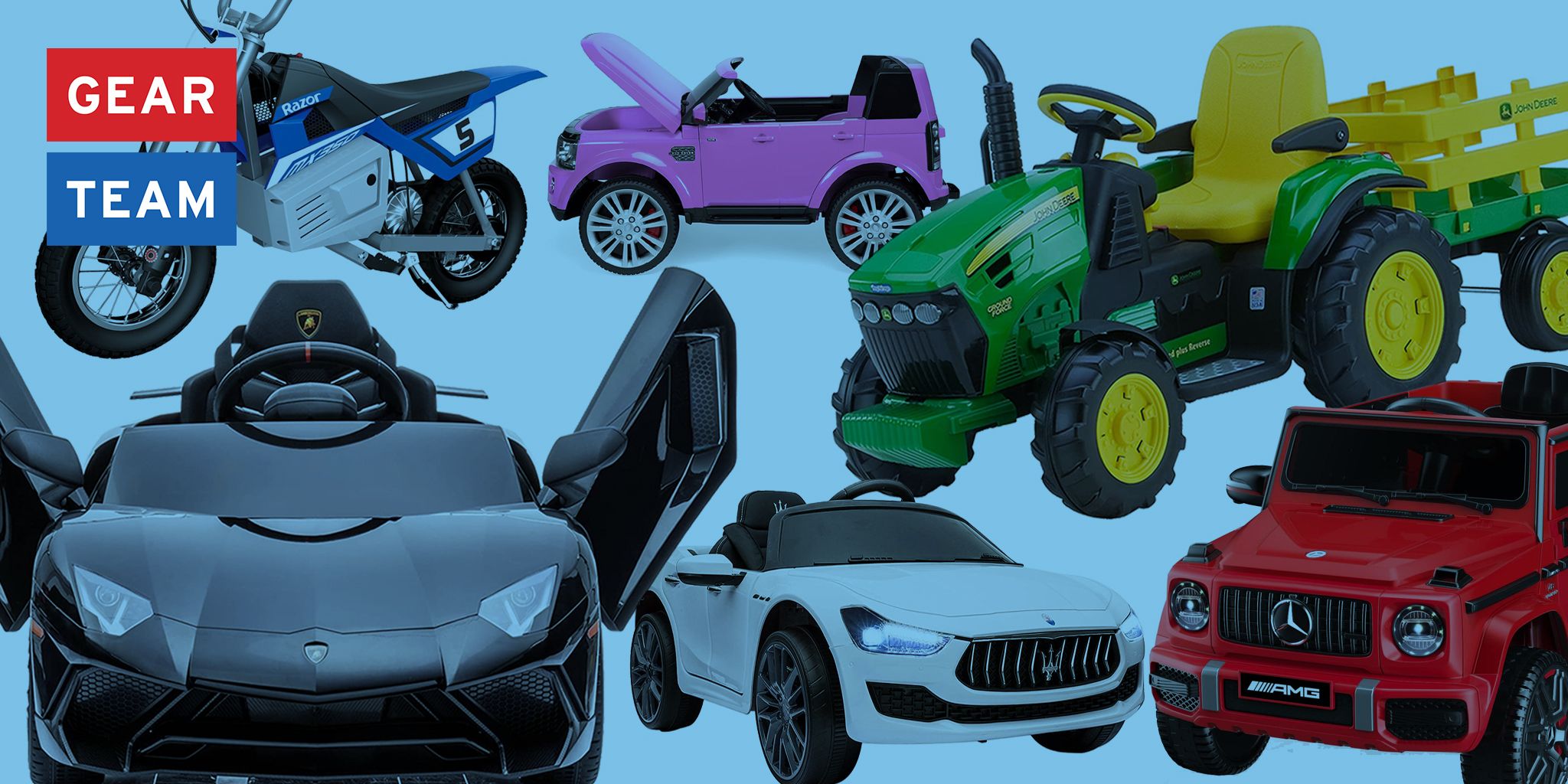Good Facts For Deciding On Kids Ride On Cars
Good Facts For Deciding On Kids Ride On Cars
Blog Article
What Do I Need Be Aware Of About The Battery's Life And Charging Time Of An Electric Ride On Children's Car?
Understanding the charging times and battery life for an electric ride on kids Cars will allow you ensure that the kids have uninterrupted play time. This article will provide you with all the information you need to be aware of about the battery type.
The majority of electronic ride-on vehicles for children use rechargeable batteries. They typically are lithium-ion batteries or lead acid batteries. In general, rechargeable lithium-ion batteries have an extended battery life as well as quicker charging times than lead-acid ones.
Battery Capacity
The battery capacity, measured in ampere-hours (Ah) or watt-hours (Wh) will determine the length of time that a ride-on vehicle will run on a single charge. Batteries with higher capacity will provide longer playing time before requiring recharging.
Run Time -
The run-time of an electric ride-on car refers how long it can operate for a continuous period of time on a single charge. This can vary depending on factors such as the battery capacity, motor power, the terrain, and weight of the driver.
The average run time of electric ride-ons varies between 30 and 2 hours. Certain battery packs with high capacity may offer longer time-to-run.
Charging Time -
Charging time is the amount of time needed for batteries to be fully charged after it is depleted. Charging times may vary depending on the battery's capacity or charger specifications.
On average, charging times for electric vehicles range from 8 to 12 hours for a full charge. Certain models could offer faster charging times, especially with lithium-ion batteries.
It is essential to adhere to the recommendations of the manufacturer for charging in order to ensure the security and longevity of the battery. Battery performance could be adversely affected if the battery has been either overcharged or undercharged.
Charge Method Charge Method
Chargers for electric ride-ons are usually plugged into the standard outlets in your home. Some models may offer quick charging or even a smart charger that monitors the battery's state of charge and adjusts the charging speed according to the condition of the battery.
Make sure whether the charging ports on ride-on cars are compatible to avoid damage to either the battery or electrical components.
Batteries for Other Use
Certain electric vehicles provide the option of buying additional batteries or extra batteries to extend play time. If you have extra batteries on-hand, you can easily swap out depleted ones to fully charged ones in order to cut down on the amount of time you are waiting for them to recharge.
By understanding the battery life and charging times of an electric ride-on kids' car it is possible to ensure that your kids will enjoy enjoyment and uninterrupted playtime while exploring their surroundings. It is essential to charge the battery as often as is possible and follow the proper charging methods. This will increase the battery's performance. Check out the most popular remote control childrens cars for more examples including electric ride on, remote control childrens car, toy with car, toy car for car, toy and car, electric car ride, ride on car, riding digger, toy toy cars, toy toy cars and more. . 
What Is The Difference Between Outdoor And Indoor The Use Of Car Models For Children?
Indoors or out, kids car models are made to be used in different situations and environments. The indoor Use Cars are distinct.
Dimensions and weight- Cars designed for indoor usage will be smaller in dimensions and weigh less which makes them more able to maneuver around narrow areas. This includes living rooms and playrooms. They're small enough to fit through tight corners and narrow passageways without causing damage to walls or furniture.
Low Ground Clearance for Indoor Use cars have low ground clearance to prevent them from getting stuck or snagged upon obstacles like carpets, rugs, or thresholds. This allows for smooth and uninterrupted movement across indoor surfaces without fear of getting stuck or tipped over.
Smooth Wheels. Indoor cars often feature wheels made of materials that are smooth, such as plastic or rubber. They provide greater grip and traction on smooth surfaces such as hardwood floors, laminate flooring or tiles. The wheels are designed to minimize noise and prevent scratching or scuffing surfaces.
Limited Speed - Indoor usage cars usually have lower maximum speeds to make sure that they are safe and secure within tight areas. This helps prevent accidents or collisions with furniture, walls or other obstacles typically found indoors.
Outdoor Use Cars -
Durable Construction: Vehicles made for outdoor use are made of strong materials like tough plastic or metal that are able to withstand rough handling, elements of the outdoors, such as moisture and sun. They are more resistant against wear and tear from exposure to the elements.
The higher the clearance of the ground is, the more able they will be to deal with bumps and uneven terrain. This allows cars to move over rough surfaces without damaging or getting stuck.
Traction Tires-The tires of cars specifically designed for outdoor use usually have treads that provide better traction or grip on slippery or uneven surfaces. This allows for better control and stability while driving over rough terrain.
Weather Resistant Components - Vehicles designed for outdoor use could include weather-resistant components such as sealed electronic components, waterproof casings or corrosion-resistant materials. These features protect the car from moisture and environmental harm. This allows them to withstand exposure to rain, mud or puddles, without compromising the performance.
Higher Speeds - Cars for outdoor use generally come with greater top speeds to make room for large spaces as well as the long distances outdoors. It offers a thrilling and thrilling experience for kids who want to explore outdoor spaces.
Parents can select a car for their kids that is suitable to their needs, indoors or outdoors, by evaluating the design and features. This will guarantee an enjoyable, safe and lasting play experience. See the recommended find out more for Audi ride on car for website recommendations including childrens electric cars, toy cars toy car, electric two seater cars, car toy car toy, electric toy car, electric toy car, car on ride, childrens electric cars, pedal car, ride ons and more. . 
What Factors Should I Be Thinking About Before Purchasing An Electric Kids Vehicle? What Are The Pros And Cons?
Consider these factors before purchasing an electric car for your child to ensure you purchase the most suitable model to fit your child's needs. Here are some important considerations and information about the cost sizes, dimensions and advantages and disadvantages.
Select an electric child's car based on the age and size of your child is. Children who are smaller and younger might prefer lightweight, compact vehicles. However, older children and people with larger bodies may need larger vehicles that can be able to accommodate them in a comfortable manner.
Car Weight and Size -
Electric kids' car models are available in various sizes. From small-scale to larger-scale replicas, they're readily available. Consider the size and weight of the car in relation to your child's age, size and strength, in addition to the space available to store and play.
Price range -
Prices for electronic children's automobiles can differ widely based on factors including brand, size, features, and quality of construction. Smaller models tend to be less expensive, with costs between $50 and $200, while larger-scale models can range between $200 and $800 or more for high-end, licensed replicas.
The pros and cons of -
Pros -
Children's electric vehicles provide endless hours of fun, imaginative play, and the chance to drive their own vehicle.
Motor Skill Development. An electric car is a great option to assist your child improve their coordination, spatial perception and fine-motor skills.
Electric cars are great for outdoor activities. They promote exercise, exploration and physical exercise.
Realistic Features: Many electric vehicles for children have realistic features like functioning lights, horns, and MP3 compatibility. This makes for a more enjoyable playing experience.
Cons
Cost - The most high-end electronic children's vehicles, particularly replicas that are licensed from the most famous car brands, can be expensive.
Battery Life: Electric cars are powered by rechargeable lithium-ion battery that have a short life and must be recharged regularly.
Safety Concerns: Electric cars pose a number of safety concerns, such as accidents, falls, or being entrapped if they're not operated by an adult and in a safe way.
Maintenance and assembly - Certain electric car require assembly when arriving and regular maintenance. This includes cleaning, battery maintenance and occasionally repairs or replacements.
Features and Accessories
Explore the available features and accessories available for your electric kids' cars such as horns that function as well as storage compartments, seatbelts as well as parental remote controls. Choose a car with features that are suitable for your child's preferences and interests.
Ultimately, the best electric car for your child is based on factors such as size, age, and interests and budget. Do your research and compare models review them, and weigh up the pros & cons before making your decision. Follow the best kids cars kidscars.co.uk news for more recommendations including electric rideons, electric car ride, car toy car toy, car toy toy, toy car, childs car toy, ride ons, electric ride along car, childrens electric cars, ride electric car and more. .